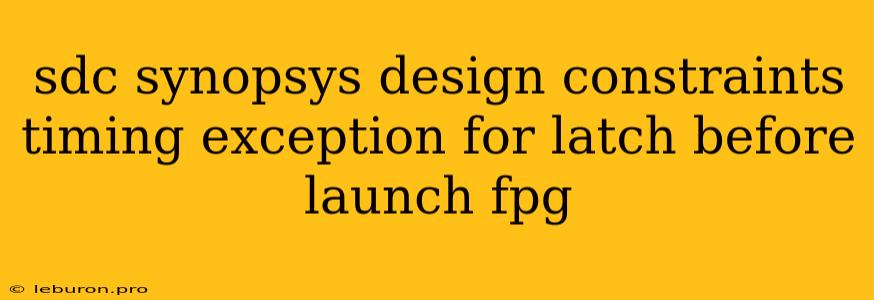Mastering SDC: Timing Exceptions and Latch Management in FPGA Design
In the realm of FPGA design, achieving optimal performance and meeting timing constraints is paramount. Synopsys Design Constraints (SDC) plays a crucial role in this process, providing a standardized language for specifying timing requirements and guiding the synthesis and place-and-route tools. One of the key aspects of SDC is the ability to define timing exceptions, allowing engineers to override default timing rules and accommodate specific design requirements. This article delves into the nuances of SDC, focusing on timing exceptions and latch management, particularly in the context of latch behavior before launch in FPGAs.
Understanding SDC and Timing Exceptions
SDC is a text-based language used to define timing constraints for digital circuits. These constraints guide the synthesis and place-and-route tools, ensuring that the resulting design meets performance targets and functional requirements. One important feature of SDC is the ability to define timing exceptions, which allow designers to override default timing rules in specific scenarios. This is essential for handling situations where the standard timing analysis may lead to overly conservative results or unnecessarily constrain the design.
Timing exceptions are used to:
- Relax timing requirements: Sometimes, signals in a design may not need to meet the typical timing constraints, for example, when dealing with asynchronous signals or low-frequency clocks. In these cases, SDC can be used to relax timing requirements, allowing for more flexible placement and routing.
- Specify specific timing behavior: In certain cases, the designer may have a specific timing behavior in mind for a particular signal or path. SDC can be used to explicitly define these timing constraints, ensuring that the tool respects the designer's intent.
- Address timing violations: During the synthesis and place-and-route process, timing violations may occur. SDC can be used to apply timing exceptions to specific paths, mitigating these violations and enabling successful design closure.
Latch Behavior and Timing Exceptions Before Launch
Latches are sequential elements that store data in an asynchronous manner. Unlike flip-flops, which are triggered by clock edges, latches are sensitive to the level of the clock signal. In FPGAs, latches are commonly used for various purposes, such as implementing asynchronous logic, buffering signals, and handling data flow in high-speed applications. However, latches can pose challenges in timing analysis, especially when considering their behavior before launch.
Launch refers to the point in time when a signal is transmitted from a source element, typically a flip-flop or latch, towards a destination. Before launch, the signal is in an undefined state, and its timing characteristics can be unpredictable. This uncertainty can lead to timing violations and hinder the design's performance.
To address these issues, SDC provides mechanisms for managing latch behavior before launch, ensuring that timing analysis is accurate and the design meets its timing requirements. These mechanisms include:
set_latch_input_delay: This command allows the designer to explicitly define the delay between the input and output of a latch before launch. This provides a way to quantify the uncertainty in the latch's behavior and factor it into the timing analysis.set_latch_output_delay: This command allows the designer to define the delay between the latch output and the next stage in the design before launch. This helps to accurately model the timing characteristics of the latch output and avoid potential timing violations.set_multicycle_path: For paths involving latches, particularly when a signal is held for multiple cycles, this command can be used to specify the delay across multiple clock cycles. This ensures that the tool accounts for the latch's holding behavior and performs accurate timing analysis.
By using these SDC commands effectively, engineers can ensure that the latch behavior is properly accounted for in timing analysis, leading to a more robust and reliable design.
Example: Managing Latch Behavior in a Design
Consider a simple example where a signal is generated by a latch and passed through a combinational logic block before being captured by a flip-flop. In this scenario, the latch output signal before launch could cause timing issues.
// Define a latch named "latch1"
create_latch latch1
// Define a flip-flop named "flipflop1"
create_clock -name clk -period 10 -waveform {0 5}
create_ff flipflop1
// Connect the latch output to the flip-flop input
connect_net -from latch1.Q -to flipflop1.D
// Apply a timing exception for the latch output before launch
set_latch_output_delay -from latch1.Q -to flipflop1.D -max 3 -launch_clock clk
In this example, the set_latch_output_delay command is used to specify a maximum delay of 3 time units for the latch output before launch. This ensures that the timing analysis considers the latch output's behavior and avoids potential timing violations.
Conclusion
Synopsys Design Constraints (SDC) plays a vital role in optimizing FPGA designs by providing a comprehensive framework for defining timing constraints and managing timing exceptions. Understanding SDC's mechanisms for handling latch behavior before launch is crucial for achieving accurate timing analysis and ensuring robust design performance. By effectively utilizing SDC commands such as set_latch_input_delay, set_latch_output_delay, and set_multicycle_path, engineers can effectively manage latch behavior and avoid potential timing pitfalls, ultimately leading to successful FPGA designs that meet their desired performance goals.
